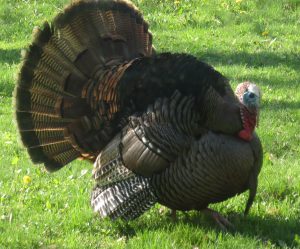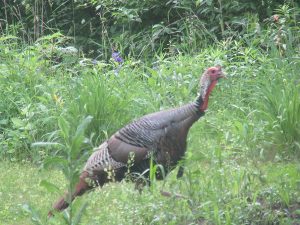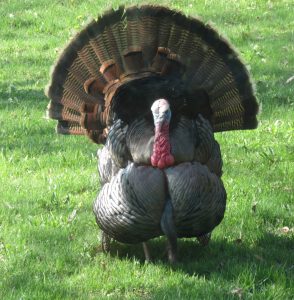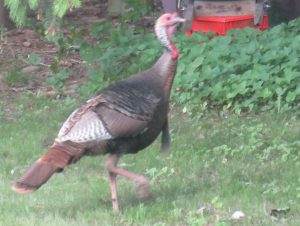He putted, turned back down the hill and sailed out of my life. That was the first time that season I ran off a gobbler by moving too soon.
Walk to a likely spot, set up, owl and crow call then knock out some lost-hen yelps on the box call. Wait five minutes and do some more turkey calling. Repeat the sequence: call, look, listen, then call again. Stay in one spot at least 30 minutes, and then move to the next likely spot.
 That morning, after about 20 minutes, I got a case of happy feet and decided to move. As I was getting to my feet, I came face to face with the biggest gobbler in three counties as he was coming over the rise in front o me. He putted, turned back down the hill and sailed out of my life. That was the first time that season I ran off a gobbler by moving too soon.
That morning, after about 20 minutes, I got a case of happy feet and decided to move. As I was getting to my feet, I came face to face with the biggest gobbler in three counties as he was coming over the rise in front o me. He putted, turned back down the hill and sailed out of my life. That was the first time that season I ran off a gobbler by moving too soon.
How soon is too soon? I don’t know. I’ve had the same thing happen after 45 minutes to an hour and a half. It doesn’t happen all the time, but it happens often enough to make me scratch my head and wonder “how long it takes to take long enough”. Every time I run a turkey off by moving too soon or trying to rush things, I re-examine the attributes of being patient and staying put.
Patience. That dull, plodding and immensely boring word has always been more of a concept than practice for me, but I don’t mind preaching it to you. Of all the turkey hunting skills you will need to cultivate, on a scale of 1 to 10, patience will get a big 9, every time.
No one is born patient. We have to learn to be patient. It is an acquired skill if you can call anything as fickle and fragile as patience a skill. We have to nurture and cultivate patience.
It takes patience to learn to be patient. I’ve worked on being patient all my life. I finally got something like a handle on it by determining and then analyzing the factors that create a “patience” atmosphere for me. Here is what I came up with: Patience equals Confidence plus Comfort multiplied by three, plus or minus Inclination. Once you know the factors that make up Patience, you can weigh the individual values of each factor for a given situation and determine how long your patience is going to hold out for a particular hunt.
 Confidence is a crucial element in the patient formula. If you are confident something good is going to happen but you just don’t know when then you can sit still for a long time. If you don’t think there any turkeys in an area you won’t have the patience to sit for long because you have no confidence in the area. If you don’t have any confidence in getting a turkey cranked up at noon, go eat lunch at noon. If you think turkeys are out there laughing at your calls, you won’t have enough confidence in your calling to stay put for long, so find at least one calling device that you have confidence in.
Confidence is a crucial element in the patient formula. If you are confident something good is going to happen but you just don’t know when then you can sit still for a long time. If you don’t think there any turkeys in an area you won’t have the patience to sit for long because you have no confidence in the area. If you don’t have any confidence in getting a turkey cranked up at noon, go eat lunch at noon. If you think turkeys are out there laughing at your calls, you won’t have enough confidence in your calling to stay put for long, so find at least one calling device that you have confidence in.
Comfort is the square foot of patience (to use another vague mathematical term). The greater your discomfort, the less time it will take for your patience to run out. Let’s take a look at some of the ways you can placate your patience with comfort enhancement.
Examining comfort from the ground up, one of the most important pieces in your arsenal is your seat cushion. You can stay in the game as long as you can sit still. When you start to wiggle and squirm you will, for sure, get caught. If you are tough enough to endure pain for long periods of time and still maintain concentration then sit on a half inch of foam, but I’m betting it will eventually bite you. Right in the butt! You can sit perfectly still for three hours then shift your weight slightly to relieve an itch and that is when you will hear the alarm putt. I know you won’t sit completely still for any length of time when you are hunting because you will be calling and looking and turning your head, but the squirming and wiggling is what seems to get them. It could be the turkeys’ innate good luck, an incessant coincidence or divine intervention by the turkey gods, but turkeys always seem to be watching you when you hope they aren’t.
 Most modern turkey vests come with cushions attached, but most of them are inadequate. The small webbed stools are comfortable, but I feel like I am less obvious if I am closer to the ground. The small inner tube stuffed in a camo pouch with a shoulder strap for easy carrying makes my long sits bearable. I sit on the inner tube and put the cushion that came attached to my vest in the game bag and use it for a back rest. I’m comfortable now; I can sit still for a long watch.
Most modern turkey vests come with cushions attached, but most of them are inadequate. The small webbed stools are comfortable, but I feel like I am less obvious if I am closer to the ground. The small inner tube stuffed in a camo pouch with a shoulder strap for easy carrying makes my long sits bearable. I sit on the inner tube and put the cushion that came attached to my vest in the game bag and use it for a back rest. I’m comfortable now; I can sit still for a long watch.
In the spring, insects and ticks are a discomfort that has to be dealt with to boost your patience quotient.
Ticks carry Lyme disease and Rocky Mountain spotted fever and some diseases that I can’t even spell. Their bite can cause severe allergic reactions. There are a couple of “repelllants” that will reduce the number of tick bites you will get in a season, but doubtful if they will eliminate all bites.
The most popular repellants contain DEET. It doesn’t really repel ticks; it confuses them. Ticks locate their hosts by zeroing in on the CO2 that is eliminated from our bodies through breath and skin pores. DEET-based repellants mask the CO2 so the tick can’t find you or doesn’t know what it has found when it does.
 The repellant I use contains Permethrin and it has been a lifesaver for me. I have been treated three times for Lyme disease, and my skin is hypersensitive to tick bits. Since I started using permethrin-based repellants 20 years ago, I only get a bite where and when I forget to spray myself. It is most effective when applied to clothing since it becomes ineffective soon after contact with skin. It does not repel ticks, it kills them. Same with chiggers.
The repellant I use contains Permethrin and it has been a lifesaver for me. I have been treated three times for Lyme disease, and my skin is hypersensitive to tick bits. Since I started using permethrin-based repellants 20 years ago, I only get a bite where and when I forget to spray myself. It is most effective when applied to clothing since it becomes ineffective soon after contact with skin. It does not repel ticks, it kills them. Same with chiggers.
Later in the spring, in certain areas of the country, mosquitoes can add to your discomfort. DEET-based repellants can effectively protect you from mosquito bites, but they are messy and irritating to eyes and sensitive skin. ThermaCELL to the rescue. This ingenious little device uses a disposable butane cartridge to heat a pad saturated with Allethrin, a synthetic copy of a naturally occurring insecticide. The heated pad disperses the fumes and creates a 15-foot by 15-foot more or less bug free zone.

